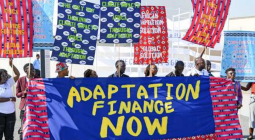Progress on structure for new global climate finance goal but trickier divides persist
Negotiators cite “convergence” on the shape of the post-2025 finance goal but gaps remain on contributors and amounts
Governments have made progress on how a new global climate finance goal should be structured – but big gaps remain on who should pay out and how large the goal should be, negotiators chairing United Nations talks said on Wednesday.
Ministers gathered in Azerbaijan’s capital Baku to discuss a new post-2025 goal for finance to help developing countries tackle climate change. A deal is due to be reached by the end of the COP29 climate summit in Baku in late November.
At the start of Wednesday’s talks, Azerbaijan’s COP29 President Mukhtar Babayev said he had seen “positive signs that there may be growing convergence on the structure of the goal”.
Zaheer Fakir, a negotiator co-chairing the UN talks on the goal, added that “parties remain apart on some of the core issues” but “substantial progress has been made” on how the goal is structured.
The other co-chair, Australian Fiona Gilbert, said “many agree” that the goal should include both the provision of public climate finance to developing countries and the mobilisation of private finance – either as a single number or as two separate numbers.
Some governments, Gilbert said, want the smaller public finance – or “core” – goal to be complemented by an additional broader goal consisting of either total investment flows to developing countries or global investment flows for climate action in all countries.
Some countries, she said, want more specific sub-goals – for example, that a certain amount of money should go towards helping developing countries adapt to more extreme weather and rising seas.
The structure of the New Collective Quantified Goal (NCQG) will not be conclusively agreed until all aspects of the goal are settled at COP29 – and some resistance remains to this proposed structure. China’s negotiator today called it “overly complex”, and criticised its reliance on the private sector.
Ambitious or realistic?
Developed and developing countries also remain split on the size of the goal and which countries should contribute.
Developing countries said on Wednesday the goal should be large enough to help meet their climate action needs and have proposed figures of between one and two trillion dollars a year.
But wealthy nations have not proposed any figures, other than saying – as already specified in the Paris Agreement – that it should be at least as large as the previous goal of $100 billion a year, which they only met two years after the target year of 2020.
US climate envoy John Podesta said in Baku that the “inner layer” of the target, meaning the public finance element, should be “ambitious and stretch parties as the $100 billion goal did- but it also has to be realistically achievable”.
He said the overall amount of finance required would be “well above $1 trillion”, adding that this should include “the outer layer” of the goal, which would consist of private, philanthropic and domestic finance provided in all countries, as well as international public finance.
Switzerland’s negotiator said “ambition does not only refer to a number – ambition also means that a goal is achievable if we collectively try our best to get there and to that end, we have to take political and economic realities into account.”
He added that an “unrealistic” goal “makes it much harder to convince finance ministries, development agencies and other actors to make all the efforts to contribute a maximum to achieve it” and warned that a failure to achieve the goal would risk breaking trust in the UN climate system.
On the other hand, the Philippines’ negotiator said the NCQG should be at least $1.3 trillion and “must be significantly supported by public finance”. “Only in this manner can we fill in the glaring financing gaps in climate action and address the challenges that disproportionately affect us,” she added.
China’s negotiator said that developed countries “must state the quantum they are willing to put on the table”.
Who should pay?
The United Nations climate convention (UNFCCC) currently groups countries into two broad camps: developed countries that are obliged to provide climate finance and developing countries that are entitled to receive it.
Developed nations like the US, UK, Japan and EU member states argue that this classification – drawn up in 1992 – is out of date as the global economy has shifted. Some developing countries like Saudi Arabia and China have become much wealthier and emit far more greenhouse gases than back then, they note.
Japan’s negotiator said an ambitious NCQG “is not achievable by the official financial resources of developed countries only”.
Switzerland’s negotiator said it would help developed countries’ environment and climate ministers to convince their finance ministries and parliaments to contribute more if they could say “we have all hands on deck – everyone’s contributing”.
But no developing countries expressed support for efforts to expand the official pool of climate finance contributors and several, particularly those targeted, expressed strong opposition to it.
China’s negotiator said: “We need to stick to what we have already agreed”, adding that “any attempts to change the rules or increase the obligations on developing countries is not in line with” the Paris Agreement or the UNFCCC.
Statements by the Arab Group and Singapore agreed with China that the list of government contributors should not be expanded.
Paris Agreement ‘sets up’ layers
Germany’s climate envoy Jennifer Morgan tried to reassure those nations, saying that “this is not about changing the status of any country” under the UN climate system and “one can be contributing and receiving at the same time”.
Brazil’s National Secretary for Climate Change Ana Toni noted that Article 9 of the Paris Agreement already states that developed countries “shall” provide climate finance, encourages developing countries to do the same “voluntarily”, and obliges developed countries to “take the lead in mobilising climate finance”. “There we have three layers already set up for us,” she said.
Commenting on the ministerial meeting in Baku, Teresa Anderson, ActionAid International’s global lead on climate justice, said talk by developed countries of a “multilayered approach” to climate finance “is code for their efforts to count loans and private investments towards the new climate finance goal”.
“If they could, rich countries would probably like to count the sun, the moon, and grandpa’s old socks as climate finance too,” she added in a statement, calling on them instead to provide “trillions of dollars in much-needed grants”.
Cover photo: A man stands in a home where the roof was ripped apart, in the aftermath of Hurricane Beryl, in St. Elizabeth Parish, Jamaica, July 5, 2024. REUTERS/Maria Alejandra Cardona



